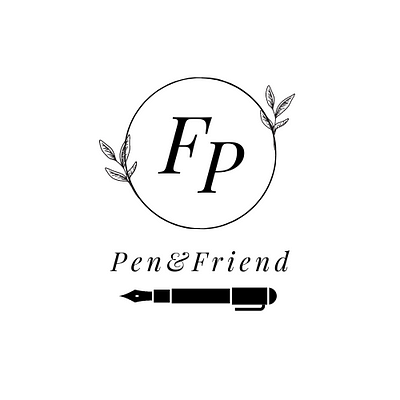Crafting Elegance and History: Exploring the World of Urushi Fountain Pens
Oct 18, 2023
Introduction
Urushi fountain pens are often favored by many fountain pen enthusiasts due to their exquisite and luxurious appearance. However, their high price deters many admirers who, though they appreciate them, find it challenging to add these pens to their collections. In the eyes of pen collectors, Urushi fountain pens are considered unique works of art rather than just writing instruments. What makes them so special? To understand this, we must begin by delving into the uniqueness of "urushi."
1.What Is Urushi?
Urushi lacquer is derived from the sap of the Urushi tree and is known for its durability, resistance to oxidation, corrosion resistance, acid resistance, rust resistance, and its ability to create intricate designs. The growth cycle of the sumac tree is very long, typically taking 5-8 years to mature before harvesting. Generally speaking, the older the tree, the better the quality of Urushi it produces. Therefore, the scarcity of raw materials is one of the reasons why lacquer pens are expensive.
2.The History of Urushi Craft
The initial awareness of lacquer pens can be traced back to Japan, and it's intriguing that the term "japan" also denotes lacquerware. This connection underscores the significant contributions of Japanese lacquer craftsmen in preserving and advancing this art form.
However, based on the information I've gathered, the credit for the world's first discovery and use of natural urushi goes to China. In 1978, Chinese archaeologists unearthed the remains of the Hemudu primitive society, dating back approximately 7,000 years, in Yuyao County, Zhejiang Province. Among the findings was a wooden bowl coated with natural urushi, confirmed through chemical and spectral analysis. This wooden bowl is now regarded as the world's oldest lacquerware.
During the Shang and Zhou dynasties (circa 1600 BC), ancient Chinese artisans had already mastered the technique of inlaying lacquerware, often using materials like turquoise and clam shell pieces.
It was during China's Han Dynasty (around 206-220 BC) that the art of lacquerware and associated craftsmanship began to be introduced to Japan.
In the Tang Dynasty (AD 618-907), the esteemed monk Master Jianzhen traveled to Japan. He not only propagated Tang Dynasty culture but also brought lacquer craftsmen with him, contributing to the development of Japanese lacquer art.
During the Yuan and Ming Dynasties (AD 1271-1644), the Japanese lacquer art system took shape and evolved into a distinctive Japanese style, fostering a climate of mutual exchange and mutual promotion between Chinese and Japanese lacquer arts.
Today, the ancient art of lacquer craftsmanship harmoniously converges with fountain pens, endowing these pens with newfound value.
3.The Production Process of Urushi Pens
The creation of a urushi fountain pen involves a meticulous process that encompasses 7 major steps, each of which can be further divided into numerous smaller stages. Most of these steps require the skilled hand of craftsmen, as they are difficult to mechanize. As a result, the production of a single piece of lacquerware, including lacquer pens, can span from several months to several years.
For instance, let's consider the urushi application stage. Craftsmen begin by refining the lacquer, carefully blending it with camphor oil, and then delicately applying it to the pen barrel. The choice of pen holder material and the number of urushi layers can vary. Some products may only require a few layers, while others demand dozens. Each layer of urushi must be allowed to naturally dry before the subsequent layer can be applied.
The shade drying process must be conducted in a specialized room with strict control over temperature and humidity. Typically, the humidity levels are maintained at about 65% to 85%, while the temperature is kept around 20 to 25 degrees Celsius.
The aforementioned description offers just a glimpse into one facet of this age-old craft. It is challenging to truly comprehend the time, patience, dedication, and enthusiasm invested by these craftsmen in completing their work. It is with the utmost respect that we view their dedication.
Even after a thousand years, lacquer pens produced through these exacting and intricate processes can continue to radiate brilliance. The complexity, the lengthy production cycle, and the necessity for handmade craftsmanship are key factors contributing to the expense of lacquer pens.
4.Common Decorative Techniques for Urushi Pens - Raden
The extensive variation in the appearance of urushi pens can be attributed to the diverse decorative techniques employed by craftsmen, and one of these techniques is Raden.
Urushi Raden Inlay is a traditional craft closely associated with Urushi. In the process of using the Raden technique, craftsmen delicately embed shell pieces into the Urushi coating to introduce decorative elements and enhance visual appeal. Raden typically employs shell flakes, often sourced from pearl shells, which possess unique luster and color characteristics.
When these shell flakes are incorporated into the Urushi coating, they can be arranged randomly as embellishments or meticulously formed into intricate patterns. The reflective qualities of these shell flakes produce a captivating sparkling effect when exposed to light, adding to the charm and allure of the finished piece.
5.Commonly Used Decorative Techniques for urushi Pens - Maki-e
Maki-e is a key secret to transforming lacquer pens into objects of exquisite luxury, a hallmark that is keenly felt in Namiki's designs. Unlike the Raden technique, Maki-e involves craftsmen drawing decorative patterns or text directly onto the Urushi coating. These decorations can encompass a wide range of designs, including flowers, birds, landscapes, traditional patterns, and more.
The materials utilized in Maki-e are often of significant value, typically encompassing gold powder, silver powder, colored pigments, and shell powder. These materials are meticulously applied, painted, and dispersed across surfaces to create intricate patterns and adornments. These patterns and decorations breathe life into even the most solid-colored pens, rendering them exceptionally vivid.
The Maki-e process typically entails several steps, including drawing, pasting, sanding, and polishing. Various Maki-e styles and techniques yield diverse effects, resulting in either flat decorations or three-dimensional patterns.
Whether it's Raden or Maki-e, both rely heavily on the skilled hands and unwavering patience of craftsmen to complete. This undoubtedly imparts the lacquer pen with the aura of a work of art, setting it apart from ordinary writing instruments.
6.Well-Known Urushi Pen Manufacturers and Models
Most of the commonly available lacquer pens on the market originate from Japan. While you may not be immediately familiar with the brands I'm about to mention, as a pen enthusiast, you've likely come across their exceptional creations.
Namiki:
Namiki stands as one of the most renowned Urushi pen manufacturers in Japan, celebrated for their exquisite Urushi craftsmanship. Namiki pens often feature intricate decorations and patterns, vividly depicting traditional Japanese cultural elements, natural landscapes, animals, flowers, and plants on the pen body.

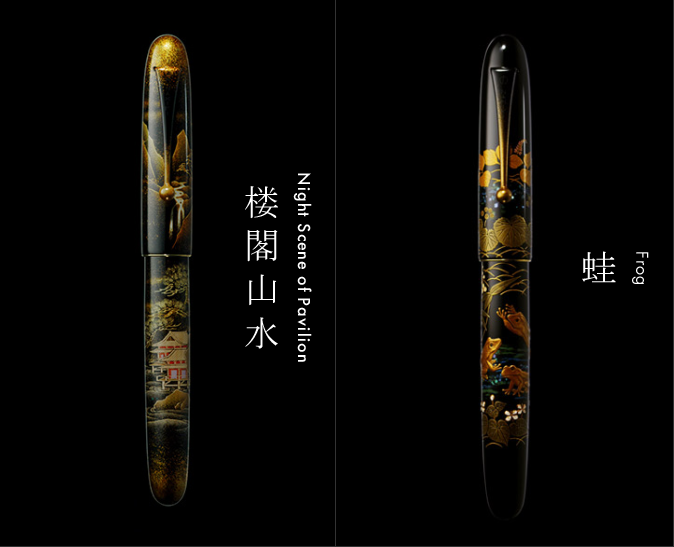
One of their most celebrated models is the "Lacquer Vermilion." Distinguished by its unique cinnabar red appearance, this Urushi fountain pen stands as one of Namiki's signature products and enjoys a special place in the hearts of many fountain pen enthusiasts and collectors.
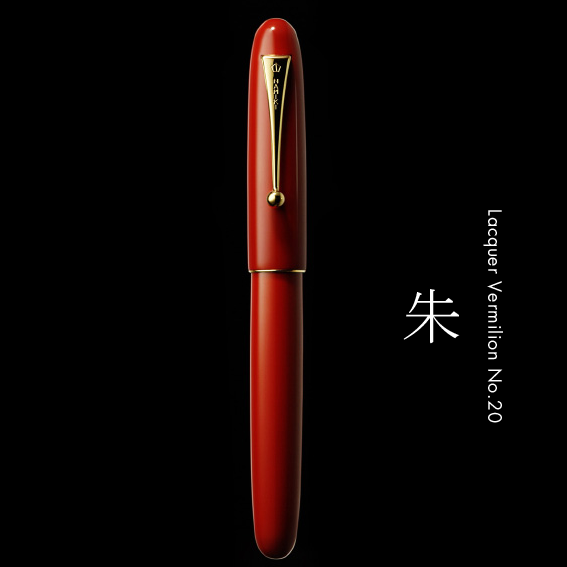
Pilot:
While you may be more familiar with Pilot, you may not be aware that it is the parent company of Namiki. Pilot also produces high-quality Urushi pens, including the well-known Pilot Custom 845 and Pilot Custom Urushi series. These two series of pens exclusively employ pure Urushi lacquer without additional decorative techniques, yet this simplicity doesn't diminish their appeal to pen aficionados.

Platinum:
Platinum, another Japanese fountain pen manufacturer, offers the Platinum Izumo Urushi and Platinum #3776 Century Urushi series.
The Izumo series is renowned for its exquisite Urushi craftsmanship and minimalist design. It predominantly features solid-color lacquer pens, with a limited number of urushi raden pens.
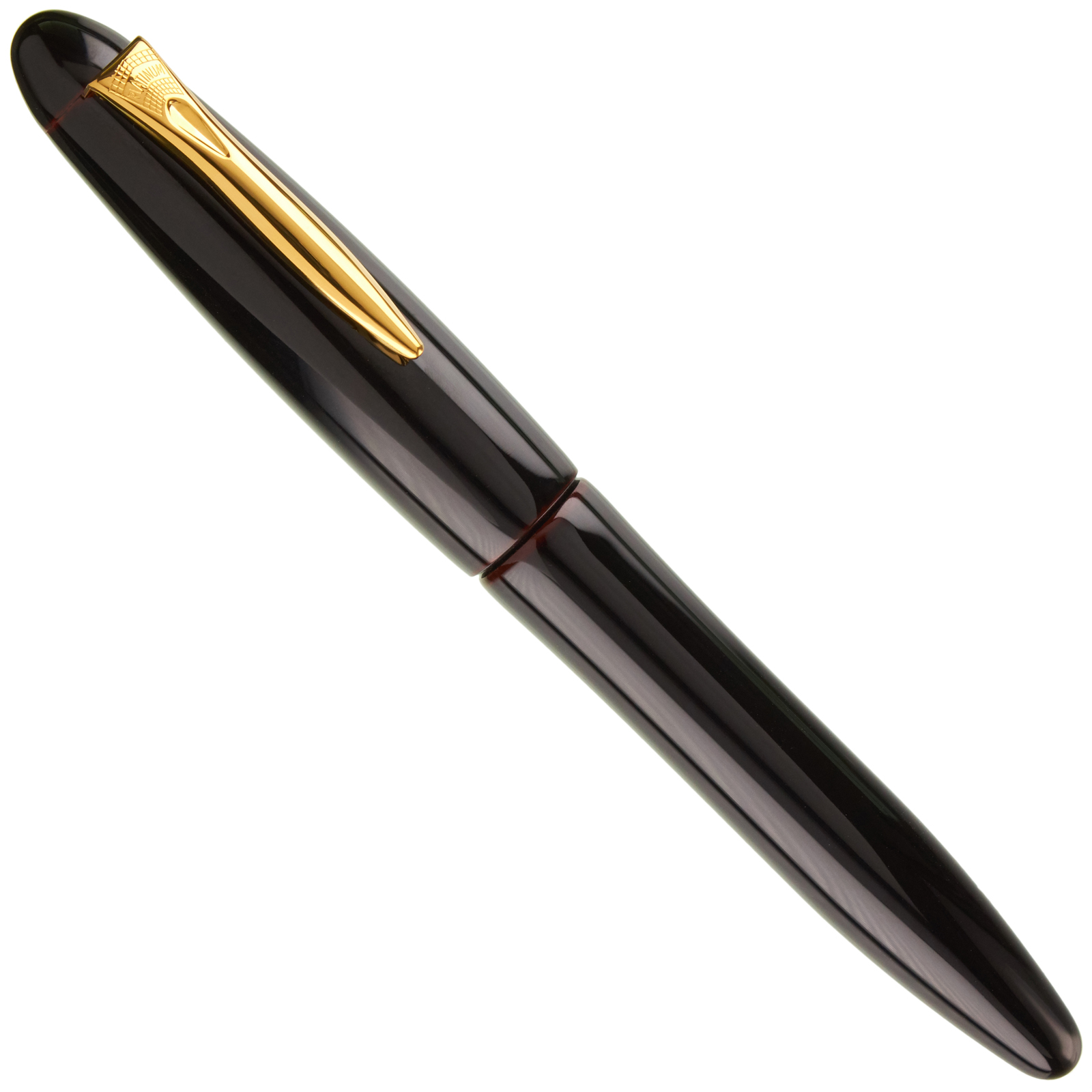

The #3776 Century Urushi series showcases intricate plant patterns painted on the pen body.

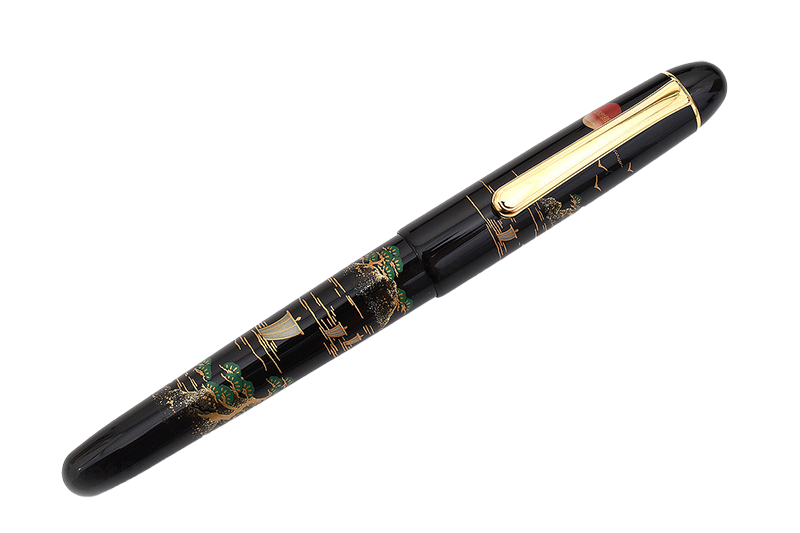
Danitrio:
Danitrio, a Japanese lacquer pen manufacturer with over 50 years of history, is celebrated for its distinctive designs. Their product lines encompass Basic painting, Genkai, Sho-genkai, Mikado, Kaijin, Takumi, Densho, Hanryo, Hyotan, and Yokozuna 10 series, each offering a variety of unique pen models. Danitrio pens often feature imaginative shapes, vibrant colors, and intricate ornamentation, capturing the attention of pen collectors.

Sailor:
Sailor's Urushi fountain pen series, known as Sailor “King of Pens Urushi”, predominantly utilizes ebonite and incorporates pure Urushi lacquer in its design. It provides a wide array of colors for customers to choose from.
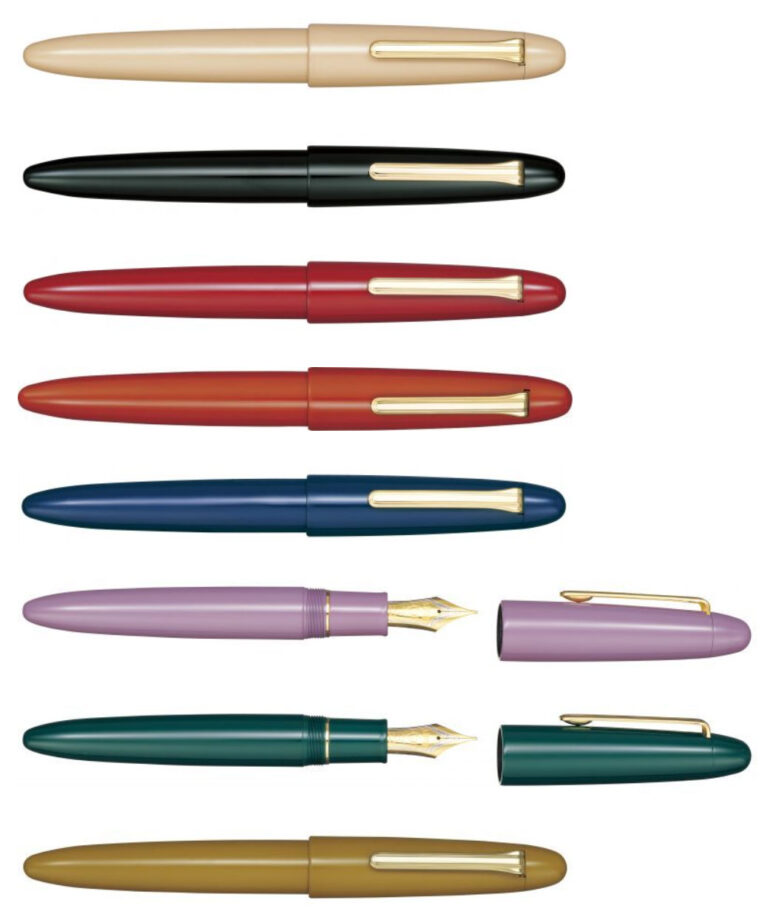
In general, numerous pen manufacturers are dedicated to preserving and advancing this ancient craft. Regrettably, I cannot list them all here. If you wish to have your lacquer pens featured in this section, please feel free to contact me via email.
7.Urushi Pen Usage Experience
From the paragraphs above, you likely understand why Urushi pens come with a significant price tag. Naturally, you may also be curious about the writing experience these pens, which can cost hundreds or even thousands of dollars, offer. Do they fulfill the fundamental function of a pen, or have they transformed into mere collectible novelties? Regrettably, I cannot personally address these questions as I can't acquire and test all these highly-priced pens one by one. However, my friend Andrew can provide insights into this matter, and I wholeheartedly recommend his YouTube channel - Pen Friends. He has been creating urushi pen review content for the past two years and is extremely committed to his audience. Prior to each online video, he rigorously uses the pen he plans to introduce for at least one month, thoroughly evaluating it from every angle to deliver the most impartial content. Hence, if you are keen on discovering or purchasing lacquer fountain pens, I encourage you to explore his channel.
8.Collection and Maintenance of Urushi Pens
The unique production process of Urushi pens necessitates a degree of consideration to preserve these exceptional works of art in their beautiful and elegant state for an extended period. Here are some of our recommendations:
Avoid Sun Exposure and High Temperatures:
Urushi fountain pens are susceptible to the effects of sunlight and high temperatures. Prolonged exposure to sunlight or high-temperature environments can lead to the peeling of the lacquer coating. To safeguard their exquisite appearance, it's advisable to refrain from leaving them in direct sunlight for extended durations.
Avoid Impacts and Falls:
This is a universal rule applicable to all pens, and lacquer pens are no exception.
Avoid Contact with Chemicals:
Substances such as salt and alkali can cause damage to lacquerware, so exercise caution to prevent contact with these substances. If the pen body becomes stained with sweat, promptly wipe it clean. Additionally, be mindful not to use abrasive or harsh cleaners when cleaning; a simple damp cloth will suffice.
Avoid Prolonged Soaking:
When cleaning the interior of pens, it is best to refrain from prolonged soaking in water. Keeping them dry is one of the key secrets to maintaining their allure over time.
After reading this, I believe you now have a relatively comprehensive understanding of urushi pens. If you've also fallen in love with this ancient art but find it challenging to invest thousands of dollars in acquiring those renowned models for your collection, then you might consider exploring our entry-level options. With a history of over 30 years as a pen manufacturer, our passion for pens is second to none. Our entry-level lacquer pen incorporates Urushi and Raden techniques, using shells to emulate planets and cherry blossoms. The production cycle spans 3-5 months. Thanks to favorable exchange rates, we can offer it to customers in Europe and the United States at a relatively cost-effective price point. While its price might not be cheap with that of typical fountain pens, in comparison to other urushi pens, I believe it can help you manage your budget effectively while providing an up-close experience with this ancient art. Check it
